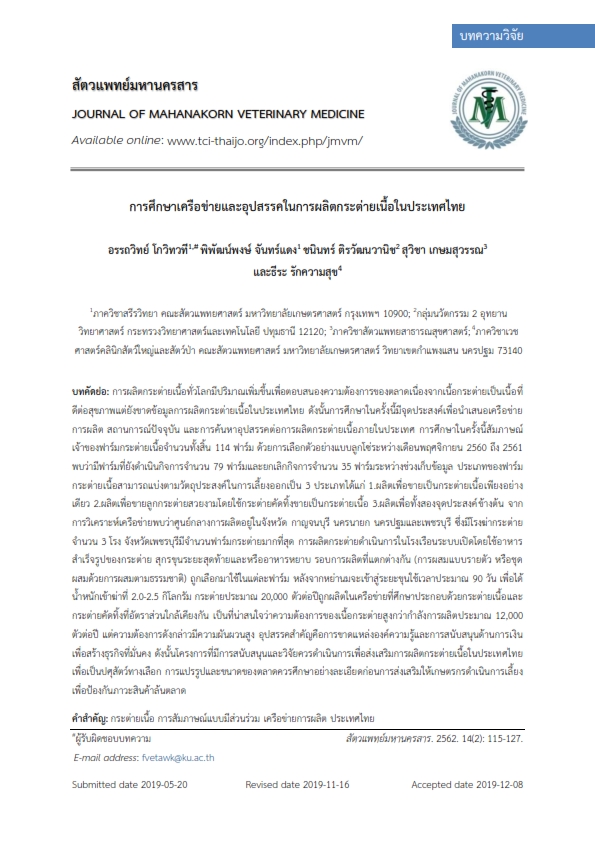The Study on Cluster and Obstacles of Meat Rabbit Production in Thailand
Main Article Content
Abstract
The meat type rabbit production in the World was reported to increase owing to rising consumer demand for healthy meat, whereas whereas there is little published data on meat type rabbit production in Thailand. Therefore, this study aimed to illustrate a network of meat type rabbit producers so to understand the current situation and to investigate any obstacles. From November 2017 to 2018, 114 owners of meat type rabbit farms were selected for interview by snowball sampling out of which 79 farms are still in business while the rest were out of business. Meat type rabbit farms were divided according to their objective into three types: 1) producing only fattening rabbits 2) selling kittens as pet and using culling rabbits for meat 3) doing 1 and 2 all together. From network analysis, the center of production was in Kanchanaburi, Nakhon Nayok, Nakhon Pathom and Phetchaburi provinces with three slaughterhouses in service. Phetchaburi province housed the highest number of rabbit farms. Rabbits were raised in the open housing system providing commercial complete rabbit or finisher pig feed and/or roughage. Using natural mating, different production cycles (individual or batch mating program) have been applied depending on farm management program. After weaning, a 90-day-fattening period has been used to reach slaughter weight at 2.0-2.5 kilograms. Within this study network, approximately 20,000 rabbits with nearly equal proportion of meat rabbits and culling pet rabbits have been produced per year. Interestingly, the demands for rabbit meat are higher than current production efficiency of around 12,000 rabbits per year. However, the demands have been fluctuate. The major obstacles are the lack of learning center to educate up-to-date knowledge and financial supporting programs to establish a concrete business. Therefore, supporting programs and research projects should be established to promote meat rabbit production in Thailand as alternative livestock. Product manufacturing and in-depth market research should be conducted prior to launching the promoting program to prevent oversupply.
Article Details
References
Dalle Zotte, A. and Z. Szendrö. 2011. The role of rabbit meat as functional food. Meat Sci. 88: 319-331.
De Blas, C. and J. Wiseman. 2010. Nutrition of the rabbit. 2nd eds. CABI. Oxford. 334 p.
El-Raffa, A.M. 2004. Rabbit production in hot climates. Proceeding in the 8th World Rabbit Congress, Puebla, Mexico, 7-10 June 2004: 1172-1180.
FAOSTAT. 2019 (cited 10 March 2019). FAOSTAT. Available from: http://faostat.fao.org/
Intachat, C., P. Jiwaganont, S. Wannasilp, O. Udompattanakorn, A. Kovitvadhi, S. Jala, D. Kawvongvan, P. Chandang, P. Lertwatcharasarakul, and P. Sanyathitiseree. 2017. Slaughterhouse seroprevalence of Encephalitozoon cuniculi in meat rabbits at Central part of Thailand. J. Mahanakorn Vet. Med. 12: 35-45.
Kovitvadhi, A. and T. Rukkwamsuk. 2015. Enhancement of growth performance and health status in rabbits by post-weaning feed restriction. J. Kasetsart Vet. 25: 87-103. (in Thai).
Kovitvadhi, A., P. Sanyathitiseree, L. Gasco, and T. Rukkwamsuk. 2016. Meat rabbit production in Central, Western and Eastern Thailand: Social network and current status. Proceeding in the 11th World rabbit congress, Qingdao, China, 15-18 June 2016: 403.
McNitt, J.I., S. D. Lukefahr, P. R. Cheeke, and N. M. Patton. 2013. Rabbit production. 9th eds. CABI, Oxfordshire. 327 p.
Social Network Visulize. 2018 (cited 25 December 2018). Social network visualize 2.4. Available from: https://socnetv.org/
Verga, M. 2014. Text book of rabbit medicine. 2nd eds. Butterworth-Heinemann. Oxford. 497 p.
Worawan, C., U. Cheevacharoen, J. Sattayapun, J. Sreepromma, S. Bantuchai, S. Kijparkorn, and P. Pernsungnern. 1985. Rabbit production. Kasetsart University, Bangkok. 114 p. (in Thai).


